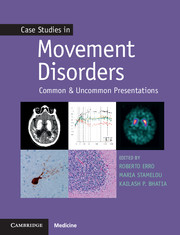30 results
Section 5 - Tremor
-
- Book:
- Case Studies in Movement Disorders
- Published online:
- 04 July 2017
- Print publication:
- 27 April 2017, pp 97-115
-
- Chapter
- Export citation
48 - Functional Palatal Tremor
- from Section 5 - Tremor
-
-
- Book:
- Case Studies in Movement Disorders
- Published online:
- 04 July 2017
- Print publication:
- 27 April 2017, pp 109-110
-
- Chapter
- Export citation
Video Captions
-
- Book:
- Case Studies in Movement Disorders
- Published online:
- 04 July 2017
- Print publication:
- 27 April 2017, pp ix-xii
-
- Chapter
- Export citation
Section 1 - Parkinsonism
-
- Book:
- Case Studies in Movement Disorders
- Published online:
- 04 July 2017
- Print publication:
- 27 April 2017, pp 1-37
-
- Chapter
- Export citation
Copyright page
-
- Book:
- Case Studies in Movement Disorders
- Published online:
- 04 July 2017
- Print publication:
- 27 April 2017, pp iv-iv
-
- Chapter
- Export citation
Section 3 - Tics
-
- Book:
- Case Studies in Movement Disorders
- Published online:
- 04 July 2017
- Print publication:
- 27 April 2017, pp 71-79
-
- Chapter
- Export citation
Previously Published Cases
-
- Book:
- Case Studies in Movement Disorders
- Published online:
- 04 July 2017
- Print publication:
- 27 April 2017, pp xvii-xviii
-
- Chapter
- Export citation
4 - Parkinson’s Disease Associated with SNCA Mutations
- from Section 1 - Parkinsonism
-
-
- Book:
- Case Studies in Movement Disorders
- Published online:
- 04 July 2017
- Print publication:
- 27 April 2017, pp 7-8
-
- Chapter
- Export citation
26 - Dystonia Complicated by Pyramidal Signs, Parkinsonism, and Cognitive Impairment: HSP11
- from Section 2 - Dystonia
-
-
- Book:
- Case Studies in Movement Disorders
- Published online:
- 04 July 2017
- Print publication:
- 27 April 2017, pp 63-64
-
- Chapter
- Export citation
39 - Dyskinesia without Levodopa: Long-Term Follow-Up of Mesencephalic Transplant in PD
- from Section 4 - Chorea
-
-
- Book:
- Case Studies in Movement Disorders
- Published online:
- 04 July 2017
- Print publication:
- 27 April 2017, pp 91-92
-
- Chapter
- Export citation
35 - Generalized Chorea with Oromandibular Involvement and Tongue Biting: Chorea-acanthocytosis
- from Section 4 - Chorea
-
-
- Book:
- Case Studies in Movement Disorders
- Published online:
- 04 July 2017
- Print publication:
- 27 April 2017, pp 83-84
-
- Chapter
- Export citation

Case Studies in Movement Disorders
- Common and Uncommon Presentations
-
- Published online:
- 04 July 2017
- Print publication:
- 27 April 2017
65 - Ataxia Telangiectasia without Ataxia
- from Section 7 - Ataxia
-
-
- Book:
- Case Studies in Movement Disorders
- Published online:
- 04 July 2017
- Print publication:
- 27 April 2017, pp 143-144
-
- Chapter
- Export citation
Abbreviations
-
- Book:
- Case Studies in Movement Disorders
- Published online:
- 04 July 2017
- Print publication:
- 27 April 2017, pp xix-xx
-
- Chapter
- Export citation
56 - Asymmetric Myoclonus and Apraxia: Corticobasal Syndrome
- from Section 6 - Myoclonus
-
-
- Book:
- Case Studies in Movement Disorders
- Published online:
- 04 July 2017
- Print publication:
- 27 April 2017, pp 125-126
-
- Chapter
- Export citation
52 - A Case of Myoclonus-Dystonia
- from Section 6 - Myoclonus
-
-
- Book:
- Case Studies in Movement Disorders
- Published online:
- 04 July 2017
- Print publication:
- 27 April 2017, pp 117-118
-
- Chapter
- Export citation
Section 6 - Myoclonus
-
- Book:
- Case Studies in Movement Disorders
- Published online:
- 04 July 2017
- Print publication:
- 27 April 2017, pp 116-133
-
- Chapter
- Export citation
59 - Prominent Myoclonus and Parkinsonism in MSA
- from Section 6 - Myoclonus
-
-
- Book:
- Case Studies in Movement Disorders
- Published online:
- 04 July 2017
- Print publication:
- 27 April 2017, pp 131-132
-
- Chapter
- Export citation
Index
-
- Book:
- Case Studies in Movement Disorders
- Published online:
- 04 July 2017
- Print publication:
- 27 April 2017, pp 151-154
-
- Chapter
- Export citation
34 - Chorea and Cognitive Difficulty: HD
- from Section 4 - Chorea
-
-
- Book:
- Case Studies in Movement Disorders
- Published online:
- 04 July 2017
- Print publication:
- 27 April 2017, pp 81-82
-
- Chapter
- Export citation



